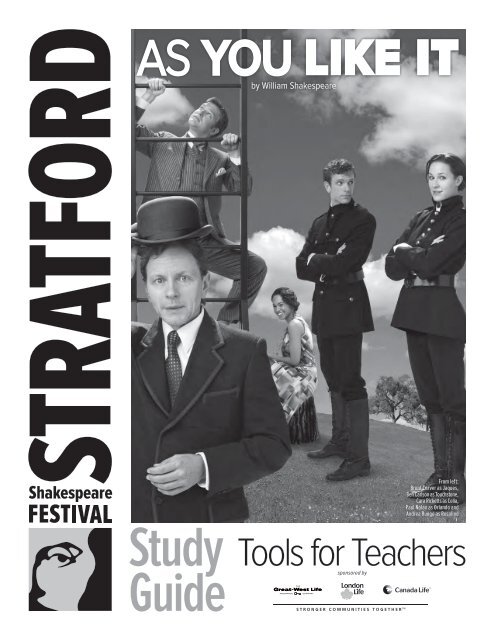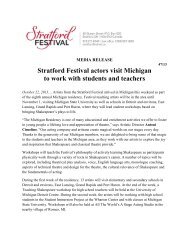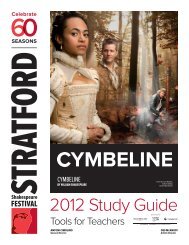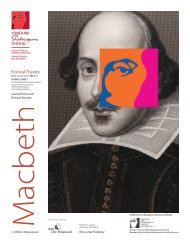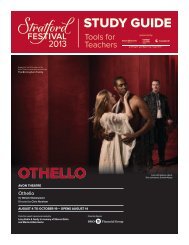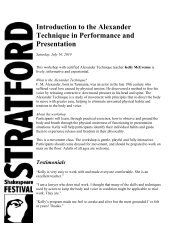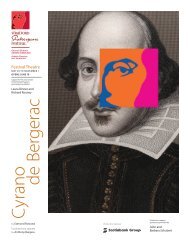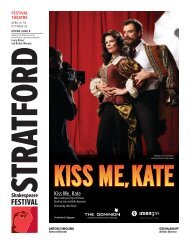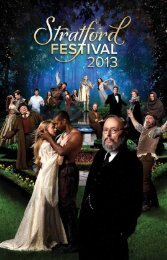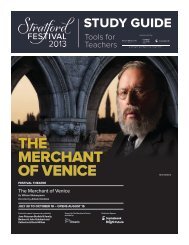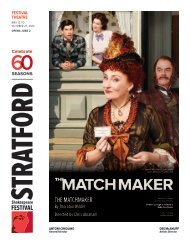study guide for As You Like It - Stratford Festival
study guide for As You Like It - Stratford Festival
study guide for As You Like It - Stratford Festival
Create successful ePaper yourself
Turn your PDF publications into a flip-book with our unique Google optimized e-Paper software.
y William Shakespeare<br />
From left:<br />
Brent Carver as Jaques,<br />
Ben Carlson as Touchstone,<br />
Cara Ricketts as Celia,<br />
Paul Nolan as Orlando and<br />
Andrea Runge as Rosalind<br />
Study<br />
Guide<br />
Tools <strong>for</strong> Teachers<br />
sponsored by
Table of Contents<br />
1. The Story ............................................................................................page 1<br />
2. Cast of Characters...................................................................................... 1<br />
3. The Playwright ........................................................................................... 2<br />
4. History of <strong>As</strong> <strong>You</strong> <strong>Like</strong> <strong>It</strong> at Strat<strong>for</strong>d ..................................................... 5<br />
5. Imaginative Ways to Approach the Text ............................................... 6<br />
6. Discussion Topics.....................................................................................12<br />
7. Resources...................................................................................................13<br />
<strong>As</strong> <strong>You</strong> <strong>Like</strong> <strong>It</strong> Study Guide<br />
Strat<strong>for</strong>d Shakespeare <strong>Festival</strong> 2010
The Story<br />
Duke Senior, whose realm has been usurped by his younger brother, Duke<br />
Frederick, lives in exile in the Forest of Arden, attended by several loyal lords,<br />
including the melancholy philosopher Jaques. Duke Senior’s daughter,<br />
Rosalind, falls in love with Orlando, who has come to Duke Frederick’s court<br />
to compete in a wrestling match; but the two are parted when she too is<br />
banished. Disguising herself as a youth named Ganymede, and accompanied<br />
by her cousin, Celia, and the court fool, Touchstone, Rosalind goes to join her<br />
father in the <strong>for</strong>est. Orlando, having learned that his elder brother, Oliver, is<br />
plotting against his life, flees there too, but does not recognize Rosalind<br />
when he meets her in her male attire. Seeing an opportunity to test the<br />
sincerity of his love, the disguised Rosalind engages Orlando in a game of<br />
romantic role-playing. Meanwhile, she must also deflect the attentions of<br />
Phebe, a shepherdess who finds “Ganymede” a much more attractive<br />
proposition than the adoring shepherd Silvius. When Orlando saves the life of<br />
Oliver, who has followed him into the <strong>for</strong>est, the brothers are reconciled. <strong>As</strong><br />
Rosalind reveals her true identity, word arrives that Duke Frederick has<br />
undergone a religious conversion and has restored Duke Senior’s crown and<br />
lands.<br />
Cast of Characters<br />
DUKE SENIOR, living in exile<br />
DUKE FREDERICK, his brother and usurper of his dominions<br />
LE BEAU, a courtier attending on Frederick<br />
CHARLES, Duke Frederick’s wrestler<br />
TOUCHSTONE, a Fool at the Duke’s court<br />
OLIVER, eldest son of Sir Rowland de Boys<br />
ORLANDO, second son of Sir Rowland de Boys<br />
JAQUES DE BOYS, youngest son of Sir Rowland de Boys<br />
DENIS, servant to Oliver<br />
ADAM, servant to Oliver<br />
AMIENS, lord attending on Duke Senior<br />
JAQUES, lord attending on Duke Senior<br />
CORIN, shepherd in the Forest of Arden<br />
SILVIUS, shepherd in the Forest of Arden<br />
WILLIAM, a country fellow<br />
SIR OLIVER MARTEXT, vicar of the country parish<br />
ROSALIND, daughter to Duke Senior<br />
CELIA, daughter to Duke Frederick<br />
PHOEBE, a shepherdess<br />
AUDREY, a goat-herd<br />
Lords attending on the Dukes, with pages and other attendants<br />
<strong>As</strong> <strong>You</strong> <strong>Like</strong> <strong>It</strong> Study Guide 1<br />
Strat<strong>for</strong>d Shakespeare <strong>Festival</strong> 2010
The Playwright:<br />
William Shakespeare<br />
Born in Strat<strong>for</strong>d-upon-Avon, a small<br />
Warwickshire town, in 1564, William<br />
Shakespeare was the eldest son of<br />
John Shakespeare, a glover, and Mary<br />
Arden, the daughter of a wealthy<br />
farmer. The exact date of his birth is<br />
unknown, but baptismal records point<br />
to it being the same as that of his death,<br />
April 23. He probably attended what is<br />
now the Edward VI Grammar School,<br />
where he would have studied Latin<br />
literature, and at 18, he married a<br />
farmer’s daughter, Anne Hathaway, with<br />
whom he had three children: Susanna,<br />
born in 1583, and, two years later, the<br />
twins Hamnet (who died in childhood)<br />
and Judith.<br />
Nothing further is known of his life until<br />
1592, when his earliest known play, the<br />
first part of Henry VI, became a hit in<br />
London, where Shakespeare was now working as an actor. Soon afterwards,<br />
an outbreak of the plague <strong>for</strong>ced the temporary closure of the theatres, and<br />
Shakespeare turned <strong>for</strong> a while to writing poetry. By 1594, however, he was<br />
back in the theatre, acting with the Lord Chamberlain’s Men. He quickly<br />
established himself as one of London’s most successful dramatists, with an<br />
income that enabled him, in 1957, to buy a mansion back in Strat<strong>for</strong>d. In 1599<br />
he became a shareholder in London’s newly built Globe Theatre.<br />
In 1603, Shakespeare’s company was awarded a royal patent, becoming<br />
known as the King’s Men. Possibly as early as 1610, the playwright retired to<br />
his home in Strat<strong>for</strong>d-upon-Avon, living there – and continuing to invest in<br />
real estate – until his death on April 23, 1616. He is buried in the town’s Holy<br />
Trinity Church.<br />
In the first collected edition of his works in 1623, fellow dramatist Ben Jonson<br />
called him a man “not of an age, but <strong>for</strong> all time”. Not only did Shakespeare<br />
write some of the most popular plays of all time, but he was a very prolific<br />
writer, writing 38 (canonically accepted) works in 23 years. His work covered<br />
many subjects and styles, including comedies, tragedies, histories, and<br />
romances, all bearing his hallmark expansive plots, extraordinary language,<br />
and humanist themes. Shakespeare enjoyed great popularity in his lifetime,<br />
and 400 years later, he is still the most produced playwright in the world.<br />
<strong>As</strong> <strong>You</strong> <strong>Like</strong> <strong>It</strong> Study Guide 2<br />
Strat<strong>for</strong>d Shakespeare <strong>Festival</strong> 2010
A Shakespearean<br />
Timeline<br />
1558 Elizabeth I crowned.<br />
1564 William Shakespeare born.<br />
1572 Actors not under the protection of a patron declared rogues and<br />
vagabonds.<br />
1576 “The Theatre,” the first public playhouse in London, opens.<br />
1577 “The Curtain,” London’s second playhouse, opens.<br />
1578 James VI (later James I of England) takes over government of<br />
Scotland.<br />
1579 Publication of North’s English translation of Plutarch’s Lives of<br />
the Noble Grecians and Romans.<br />
1580 Francis Drake returns in triumph <strong>for</strong>m his voyage around the<br />
world; travelling players per<strong>for</strong>m at Strat<strong>for</strong>d.<br />
1582 Shakespeare marries Anne Hathaway; Susanna is born six<br />
months later and the twins Hamnet and Judith in 1585.<br />
1587 “The Rose” theatre opens in London. Mary Queen of Scots is<br />
executed.<br />
1588 Spanish Armada defeated.<br />
1589 Shakespeare finds work as an actor in London; he lives apart<br />
from his wife <strong>for</strong> 21 years.<br />
1590-1591 The Two Gentlemen of Verona, The Taming of the Shrew.<br />
1591 2 Henry VI, 3 Henry VI.<br />
1592 Thousands die of plague in London; theatres closed. 1 Henry VI,<br />
Titus Andronicus, Richard III.<br />
1593 The Comedy of Errors.<br />
1594 Shakespeare becomes a shareholder of his theatre company,<br />
the Lord Chamberlain’s Men.<br />
1594 Love’s Labour’s Lost.<br />
1595 Richard II, Romeo and Juliet, A Midsummer Night’s Dream.<br />
1596 Shakespeare’s son, Hamnet, dies.<br />
1596-1597 King John, The Merchant of Venice, 1 Henry IV.<br />
1597-1598 The Merry Wives of Windsor, 2 Henry IV, Much Ado About<br />
Nothing.<br />
1598 “The Globe” theatre built.<br />
1598-1599 Henry V, Julius Caesar.<br />
<strong>As</strong> <strong>You</strong> <strong>Like</strong> <strong>It</strong> Study Guide 3<br />
Strat<strong>for</strong>d Shakespeare <strong>Festival</strong> 2010
1599-1600 <strong>As</strong> <strong>You</strong> <strong>Like</strong> <strong>It</strong>.<br />
1600-1601 Hamlet, Twelfth Night.<br />
1601 Shakespeare’s patron arrested <strong>for</strong> treason following the Essex<br />
rebellion; he is later pardoned.<br />
1602 Troilus and Cressida.<br />
1603 Queen Elizabeth dies and is succeeded by James I;<br />
Shakespeare’s theatre company becomes the King’s Men.<br />
1603 Measure <strong>for</strong> Measure, Othello.<br />
1604 Work begins on the King James Bible.<br />
1604-1605 All’s Well That Ends Well, Timon of Athens, King Lear (Q)<br />
1606 Macbeth, Antony and Cleopatra.<br />
1607 Pericles.<br />
1608 Coriolanus.<br />
1609 The Winter’s Tale.<br />
1610 King Lear (F), Cymbeline.<br />
1610 Shakespeare retires to Strat<strong>for</strong>d-upon-Avon.<br />
1611 The Tempest.<br />
1611 King James Bible published.<br />
1613 Henry VIII (All Is True), The Two Noble Kinsmen.<br />
1613 “The Globe” theatre burns down.<br />
1616 Shakespeare dies in Strat<strong>for</strong>d-upon-Avon.<br />
1623 The first folio of Shakespeare’s collected plays is published.<br />
* Some dates are approximate.<br />
<strong>As</strong> <strong>You</strong> <strong>Like</strong> <strong>It</strong> Study Guide 4<br />
Strat<strong>for</strong>d Shakespeare <strong>Festival</strong> 2010
<strong>Festival</strong> Production<br />
History<br />
There have been 10 other productions of <strong>As</strong> <strong>You</strong> <strong>Like</strong> <strong>It</strong> at the Strat<strong>for</strong>d<br />
Shakespeare <strong>Festival</strong>.<br />
1959 (<strong>Festival</strong> Theatre): Directed by Peter Wood, with William Hutt as Jaques,<br />
William Sylvester as Orlando, Irene Worth as Rosalind and Douglas Campbell<br />
as Touchstone. Designed by Desmond Heeley.<br />
1972 (<strong>Festival</strong> Theatre): Directed by William Hutt, with Roland Hewgill as<br />
Jaques, Nicholas Pennell as Orlando, Carole Shelley as Rosalind and Edward<br />
Atienza as Touchstone. Designed by Alan Barlow.<br />
1977 and 1978 (<strong>Festival</strong> Theatre): Directed by Robin Phillips, with Brian<br />
Bed<strong>for</strong>d as Jaques, Jack Wetherall as Orlando, Maggie Smith as Rosalind and<br />
Bernard Hopkins as Touchstone. Designed by Robin Fraser Paye.<br />
1983 (<strong>Festival</strong> Theatre): Directed by John Hirsch, with Nicholas Pennell as<br />
Jaques, Andrew Gillies as Orlando, Roberta Maxwell as Rosalind and Lewis<br />
Gordon as Touchstone. Designed by Desmond Heeley.<br />
1987 (Third Stage, now the Tom Patterson Theatre): Directed by Robin<br />
Phillips, with Peter Donaldson as Jaques, Nigel Hamer as Orlando, Nancy<br />
Palk as Rosalind and Albert Schultz as Touchstone. Designed by Patrick<br />
Clark.<br />
1990 (<strong>Festival</strong> Theatre): Directed by Richard Monette, with David William and<br />
Peter Donaldson as Jaques, Ronn Sarosiak as Orlando, Lucy Peacock as<br />
Rosalind and William Dunlop as Touchstone. Designed by Debra Hanson.<br />
1996 (Tom Patterson Theatre): Directed by Richard Rose, with David Jansen<br />
as Jaques, Jonathan Crombie as Orlando, Kristina Nicoll and Jane Spidell as<br />
Rosalind and Kevin Bundy as Touchstone. Designed by Charlotte Dean.<br />
2000 (Avon Theatre): Directed by Jeannette Lambermont, with Juan Chioran<br />
as Jaques, Donald Carrier as Orlando, Lucy Peacock as Rosalind and Brian<br />
Tree as Touchstone. Designed by Douglas Paraschuk.<br />
2005 (<strong>Festival</strong> Theatre): Directed by Antoni Cimolino, with Graham Abbey as<br />
Jaques, Dion Johnstone as Orlando, Sara Topham as Rosalind and Stephen<br />
Ouimette as Touchstone. Designed by Santo Loquasto.<br />
<strong>As</strong> <strong>You</strong> <strong>Like</strong> <strong>It</strong> Study Guide 5<br />
Strat<strong>for</strong>d Shakespeare <strong>Festival</strong> 2010
Imaginative Ways to Approach the Text<br />
All the World’s a Stage:<br />
Pageant<br />
Grade Level 9 - 12<br />
Ontario Listening to Understand<br />
Curriculum Speaking to Communicate<br />
Expectations Reading <strong>for</strong> Meaning<br />
Writing: Developing and Organizing Content<br />
Drama: Theory, Creation, Analysis<br />
Dance: Theory, Creation, Analysis<br />
Music: Theory<br />
Time Needed two class periods<br />
Space<br />
Materials<br />
enough room <strong>for</strong> eight groups to rehearse separately<br />
Jaques’ speech “All the world’s a stage…”, from <strong>As</strong> <strong>You</strong><br />
<strong>Like</strong> <strong>It</strong>, Act 2, scene 7 (see page 7). One copy per student.<br />
Setting up the exercise:<br />
Distribute copies of the speech. Have the class read the text in unison.<br />
Discuss the imagery in the text: what mental pictures does each of the<br />
“seven ages” evoke?<br />
Split the class into eight groups.<br />
<strong>As</strong>sign one “age” to each of seven groups; the eighth group is the<br />
chorus.<br />
The exercise:<br />
Each group will create an original vignette that embodies the spirit of<br />
their “age.”<br />
The vignette can be set in any time period.<br />
Each “age” vignette must include:<br />
o original dialogue between the characters<br />
o a song from the chosen time period<br />
o accompanying movement, appropriate to the song and time<br />
period<br />
o appropriate costumes<br />
Each “age” group will choose a site in the school to per<strong>for</strong>m their<br />
vignette.<br />
The chorus group will also choose a time period with appropriate<br />
costumes, movement and a song.<br />
When all are ready to per<strong>for</strong>m:<br />
The entire class travels to the site of the first vignette; the chorus<br />
group provides travel accompaniment with their song.<br />
Upon arrival at the first site, the first “age” group per<strong>for</strong>ms their<br />
vignette.<br />
Travel on to the next site with accompaniment from the chorus group,<br />
and so on.<br />
<strong>As</strong> <strong>You</strong> <strong>Like</strong> <strong>It</strong> Study Guide 6<br />
Strat<strong>for</strong>d Shakespeare <strong>Festival</strong> 2010
<strong>As</strong> <strong>You</strong> <strong>Like</strong> <strong>It</strong>, Act 2, scene 7<br />
Jaques:<br />
All the world’s a stage,<br />
And all the men and women merely players:<br />
They have their exits and their entrances;<br />
And one man in his time plays many parts,<br />
His acts being seven ages. At first the infant,<br />
Mewling and puking in the nurse’s arms.<br />
And then the whining school-boy, with his satchel<br />
And shining morning face, creeping like snail<br />
Unwillingly to school. And then the lover,<br />
Sighing like furnace, with a woeful ballad<br />
Made to his mistress’ eyebrow. Then a soldier,<br />
Full of strange oaths and bearded like the pard,<br />
Jealous in honour, sudden and quick in quarrel,<br />
Seeking the bubble reputation<br />
Even in the cannon’s mouth. And then the justice,<br />
In fair round belly with good capon lined,<br />
With eyes severe and beard of <strong>for</strong>mal cut,<br />
Full of wise saws and modern instances;<br />
And so he plays his part. The sixth age shifts<br />
Into the lean and slippered pantaloon,<br />
With spectacles on nose and pouch on side,<br />
His youthful hose, well saved, a world too wide<br />
For his shrunk shank; and his big manly voice,<br />
Turning again toward childish treble, pipes<br />
And whistles in his sound. Last scene of all,<br />
That ends this strange eventful history,<br />
Is second childishness and mere oblivion,<br />
Sans teeth, sans eyes, sans taste, sans everything.<br />
<strong>As</strong> <strong>You</strong> <strong>Like</strong> <strong>It</strong> Study Guide 7<br />
Strat<strong>for</strong>d Shakespeare <strong>Festival</strong> 2010
Imaginative Ways to Approach the Text<br />
In <strong>You</strong>r Own Words<br />
Grade Level 7 - 12<br />
Ontario<br />
Curriculum<br />
Expectations<br />
read and demonstrate an understanding of a variety of<br />
literary… texts, using a range of strategies to construct<br />
meaning (7/8)<br />
generate, gather, and organize ideas and in<strong>for</strong>mation to<br />
write <strong>for</strong> an intended purpose and audience (7/8)<br />
draft and revise their writing… (7/8)<br />
Developing and Organizing Content (Writing 9 - 12)<br />
Using Knowledge of Form and Style (Writing 9 - 12)<br />
Applying Knowledge of Conventions (Writing 9 - 12)<br />
Time Needed one class period<br />
Space writing desks<br />
Materials Jaques de Boys’s speech from <strong>As</strong> <strong>You</strong> <strong>Like</strong> <strong>It</strong> relating<br />
Duke Frederick’s religious conversion: Act 5, scene 4<br />
(see page 9)<br />
Setting up the exercise:<br />
Read Jaques de Boys’s short speech. He describes a scene we don’t<br />
see in the play – we only hear about it from him.<br />
The exercise:<br />
Write a short story elaborating Jaques de Boys’s account of Duke<br />
Frederick’s conversion.<br />
Questions to consider:<br />
o How does the conversion really happen?<br />
o Is Jaques de Boys telling the truth?<br />
o What else might have happened to Duke Frederick besides<br />
what Jaques says?<br />
Possible extensions:<br />
Create a screenplay from this story.<br />
Film it at school, using students and teachers as actors.<br />
Use it as a “bonus feature” in your class’s film version of <strong>As</strong> <strong>You</strong> <strong>Like</strong><br />
<strong>It</strong>.<br />
<strong>As</strong> <strong>You</strong> <strong>Like</strong> <strong>It</strong> Study Guide 8<br />
Strat<strong>for</strong>d Shakespeare <strong>Festival</strong> 2010
Jaques de Boys’s telling of Duke Frederick’s religious conversion:<br />
Duke Frederick, hearing how that every day<br />
Men of great worth resorted to this <strong>for</strong>est,<br />
Addressed a mighty power, which were on foot,<br />
In his own conduct, purposely to take<br />
His brother here and put him to the sword.<br />
And to the skirts of this wild wood he came<br />
Where, meeting with an old religious man,<br />
After some question with him, was converted<br />
Both from his enterprise and from the world,<br />
His crown bequeathing to his banished brother,<br />
And all their lands restored to them again<br />
That were with him exiled. This to be true<br />
I do engage my life.<br />
<strong>As</strong> <strong>You</strong> <strong>Like</strong> <strong>It</strong> Study Guide 9<br />
Strat<strong>for</strong>d Shakespeare <strong>Festival</strong> 2010
Imaginative Ways to Approach the Text<br />
The Rhymes of the Forest<br />
Grade Level 9 -12<br />
Ontario<br />
Curriculum<br />
Expectations<br />
Writing:<br />
Developing and Organizing content<br />
Using Knowledge of Form and Style<br />
Applying Knowledge of Conventions<br />
Time Needed one class period<br />
Space desks that can be arranged in three working groups<br />
Materials small papers<br />
hat, bowl or other container<br />
writing paper and pens or pencils<br />
Be<strong>for</strong>e you begin:<br />
Read <strong>As</strong> <strong>You</strong> <strong>Like</strong> <strong>It</strong> up to Act 3, scene 2.<br />
Setting up the exercise:<br />
Each student writes down, on a small piece of paper, two rhyming<br />
words about the same subject. Subjects can be anything, such as:<br />
o love<br />
o jealousy<br />
o the school principal<br />
o student’s significant other<br />
Students fold up their papers and place them in a hat (or bowl or trash<br />
can).<br />
Give the class the Ground Rules <strong>for</strong> a Sonnet (see page 11).<br />
<strong>As</strong> practice, ask each student to come up with one line of their own<br />
text in iambic pentameter.<br />
Have each student speak their line out loud; have the rest of the class<br />
decide whether it follows iambic pentameter.<br />
The exercise:<br />
Divide the class into three groups.<br />
Each group pulls two papers from the hat. Each paper has two rhyming<br />
words, written down earlier.<br />
Each group creates four iambic lines of text (a quatrain) using the<br />
rhyming words they picked from the hat.<br />
Each group presents their quatrain to the rest of the class.<br />
The class decides together how to arrange and adjust the three<br />
quatrains to <strong>for</strong>m the first three stanzas of a sonnet.<br />
The class works together to create the final rhyming couplet to finish<br />
the sonnet.<br />
<strong>As</strong> <strong>You</strong> <strong>Like</strong> <strong>It</strong> Study Guide 10<br />
Strat<strong>for</strong>d Shakespeare <strong>Festival</strong> 2010
Ground Rules <strong>for</strong> a<br />
Sonnet<br />
A sonnet follows a strict rhyme scheme and a specific structure.<br />
<br />
<br />
<br />
A Shakespearean, or English, sonnet consists of 14 lines, each line<br />
containing 10 syllables and written in iambic pentameter.<br />
Iambic pentameter:<br />
o five “feet” per line<br />
o each “foot” consists of an unstressed syllable followed by a<br />
stressed syllable<br />
o the resulting sound is de DUM de DUM de DUM de DUM de<br />
DUM<br />
The rhyme scheme of a Shakespearean sonnet is a-b-a-b, c-d-c-d, e-fe-f,<br />
g-g (the last two lines are a rhyming couplet).<br />
Example:<br />
Shakespeare’s Sonnet #2<br />
When <strong>for</strong>ty winters shall besiege thy brow,<br />
And dig deep trenches in thy beauty's field,<br />
Thy youth's proud livery, so gazed on now,<br />
Will be a tattered weed, of small worth held:<br />
Then being asked where all thy beauty lies,<br />
Where all the treasure of thy lusty days,<br />
To say, within thine own deep-sunken eyes,<br />
Were an all-eating shame and thriftless praise.<br />
How much more praise deserved thy beauty's use,<br />
If thou couldst answer, “This fair child of mine<br />
Shall sum my count and make my old excuse,”<br />
Proving his beauty by succession thine!<br />
This were to be new made when thou art old,<br />
And see thy blood warm when thou feel'st it cold.<br />
<strong>As</strong> <strong>You</strong> <strong>Like</strong> <strong>It</strong> Study Guide 11<br />
Strat<strong>for</strong>d Shakespeare <strong>Festival</strong> 2010
Discussion Topics <strong>for</strong><br />
<strong>You</strong>r Class<br />
For classes reading the play be<strong>for</strong>e seeing it:<br />
1. What do you expect to see on stage at the Strat<strong>for</strong>d Shakespeare <strong>Festival</strong>?<br />
Have each student make a list of predictions about what they expect. Save<br />
these predictions. After your Strat<strong>for</strong>d trip, revisit them to see how they<br />
compared to the actual production.<br />
2. Create a character web showing how all the characters are connected to<br />
each other. Discuss the complexity of these relationships and how they affect<br />
the progression of the play.<br />
After your Strat<strong>for</strong>d trip:<br />
1. <strong>As</strong> <strong>You</strong> <strong>Like</strong> <strong>It</strong> has appealed to artists and audiences around the world <strong>for</strong><br />
400 years. What do you think the play’s message is?<br />
2. What parts did you respond to most?<br />
3. Were there parts you wished were different? How?<br />
For more classroom activities, complete with instructions, materials and<br />
Ontario curriculum expectation links, visit<br />
strat<strong>for</strong>dshakespearefestival.com/teachingmaterials.<br />
<strong>As</strong> <strong>You</strong> <strong>Like</strong> <strong>It</strong> Study Guide 12<br />
Strat<strong>for</strong>d Shakespeare <strong>Festival</strong> 2010
Resources<br />
SHAKESPEARE: HISTORY, CRITICISM and BIOGRAPHY:<br />
Beckerman, Bernard. Shakespeare and the Globe, 1599-1609. 1962.<br />
Bentley, G.E. Shakespeare: A Biographical Handbook. 1951.<br />
Boyce, Charles. Shakespeare A to Z. 1990.<br />
Brown, Ivor. Shakespeare and the Actors. 1970.<br />
Brown, John Russell. Shakespeare and his Theatre.<br />
Burgess, Anthony. Shakespeare. 1970.<br />
Campbell, Oscar James, ed. The Reader’s Encyclopedia of Shakespeare.<br />
1966.<br />
Dobson, Michael, ed. The Ox<strong>for</strong>d Companion to Shakespeare. 2001.<br />
Epstein, Norrie. The Friendly Shakespeare. 1992.<br />
Frye, R. M. Shakespeare’s Life and Times: a Pictorial Record. 1067.<br />
Gurr, Andrew. The Shakespearean Stage, 1574-1642. 1980.<br />
Hodges, C. Walter. Shakespeare and the Players. 1948.<br />
Muir, Kenneth and Samuel Schoenbaum, eds. A New Companion to<br />
Shakespeare Studies, 1985.<br />
Nagler, A. M. Shakespeare’s Stage. 1985.<br />
Schoenbaum, Samuel. William Shakespeare: A Documentary Life. 1975.<br />
Taylor, Gary. Reinventing Shakespeare. 1989.<br />
Thomson, Peter. Shakespeare’s Theatre. 1983.<br />
Tillyard, E. M. W. The Elizabethan World Picture. 1943.<br />
Wells, Stanley, ed. The Cambridge Companion to Shakespeare Studies.<br />
1986.<br />
AS YOU LIKE IT:<br />
Gibson, Rex. Teaching Shakespeare. 1998.<br />
Shakespeare, William. <strong>As</strong> <strong>You</strong> <strong>Like</strong> <strong>It</strong>. Cambridge School. 2000.<br />
Shakespeare, William. <strong>As</strong> <strong>You</strong> <strong>Like</strong> <strong>It</strong>. Arden. 1975<br />
ONLINE RESOURCES:<br />
Mr. William Shakespeare and the Internet, shakespeare.palomar.edu<br />
Sh:in:E Shakespeare in Europe, www.unibas.ch/shine<br />
Encyclopaedia Britannica presents: Shakespeare and the Globe: Then and<br />
Now, search.eb.com/shakespeare<br />
Shakespeare’s Life and Times,<br />
web.uvic.ca/shakespeare/Library/SLT/intro/introsubj.html<br />
Shakespeare Online, www.shakespeare-online.com<br />
Movie Review Query Engline, www.mrqe.com<br />
Internet Movie Database, www.imdb.com<br />
<strong>As</strong> <strong>You</strong> <strong>Like</strong> <strong>It</strong> Study Guide 13<br />
Strat<strong>for</strong>d Shakespeare <strong>Festival</strong> 2010
AS YOU LIKE IT ONLINE:<br />
MIT Shakespeare Homepage: The Complete Works of William Shakespeare,<br />
the-tech.mit.edu/Shakespeare/<br />
AS YOU LIKE IT ON FILM, VIDEO and DVD:<br />
1936 (UK): Directed by Paul Czinner, starring Elizabeth Bergner and Laurence<br />
Olivier.<br />
1978 (UK): Part of the BBC TV series, starring Helen Mirren and Brian Stirner.<br />
1984: (Canada): Strat<strong>for</strong>d Shakespeare <strong>Festival</strong> production directed by John<br />
Hirsch, starring Roberta Maxwell and Andrew Gillies.<br />
1992 (UK): Directed by Christine Edzard, starring Emma Croft and Andrew<br />
Tiernan.<br />
<strong>As</strong> <strong>You</strong> <strong>Like</strong> <strong>It</strong> Study Guide 14<br />
Strat<strong>for</strong>d Shakespeare <strong>Festival</strong> 2010


